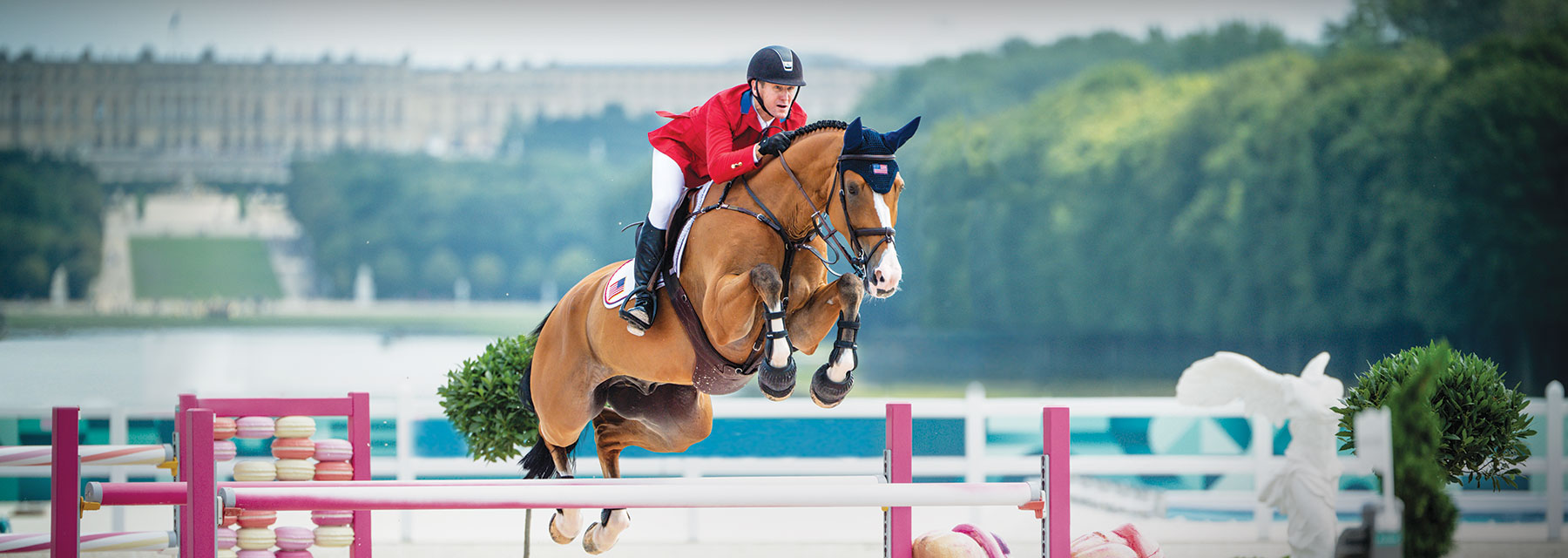Showcasing Thrilling Performances of Elite Equestrian Athleticism Against the Canvas of Parisian Elegance at the Château de Versailles
Being selected for the Olympics is a pinnacle achievement in an athlete’s career. For riders representing their country at the 2024 Paris Olympics, the selection was not just an honor but a testament to their exceptional skills and perseverance, a dream realized through years of dedication, training and unwavering commitment. The journey to the Olympics unquestionably involved countless hours in the saddle, rigorous training and overcoming numerous challenges, all culminating in the ultimate reward of competing on the world’s biggest stage.
Appreciating the uniqueness of being an Olympic equestrian is essential to truly admire the splendor of the performances witnessed at the Summer Games. Unlike many Olympic disciplines, equestrian sports involve a unique dynamic where the athlete’s partner is a living, breathing horse. This partnership introduces a layer of complexity and collaboration that sets equestrian events apart. Riders must build and maintain a strong bond with their horses, built on mutual trust, respect and understanding. The horse is not just an athletic partner but a teammate. Success relies not only on the rider’s skill and strategy but also on an ability to communicate and synchronize with their equine teammates, understanding their mood, reactions and needs. This living partnership adds a depth of challenge and artistry to the discipline, making it a key component of the equestrian Olympic journey.
“These top performance horses, every step that they take is planned. Platinum Performance® has just been wonderful for the horses. You can see it in their conditioning, recovery time and overall fitness.”
— McLain Ward, Platinum Performance® Client since 2003
McLain Ward: Another Olympics, Another Medal
McLain Ward has established himself as one of the premier show jumpers of modern times through his remarkable Olympic career alone. The 48-year-old has competed in the Games six consecutive times. His Olympic record reflects both consistency and success, with a total of five Olympic medals. Ward first made a significant impact at the 2004 Athens Olympics, where he won a gold medal in team show jumping only to later win another in 2008. His subsequent appearances at the 2016 Rio de Janeiro and COVID-delayed 2021 Tokyo Games further solidified his reputation, helping the U.S. team secure silver medals.
At the Paris Olympics, he competed on his talented horse, Ilex (Baltic VDL x Chin Chin), an 11-year-old KWPN gelding. The partnership showcased technical expertise, agility and precision, as they delivered a compelling performance. Ward demonstrated his trademark skills and composure under pressure during the team event. Despite the highly competitive field, his performance was marked by a clear round that helped secure a team silver medal further adding to his impressive Olympic tally. Ward’s numerous Olympic appearances and multiple medals underscore his extraordinary career and his enduring impact on the sport of show jumping. Although his 2024 performance on Ilex did not earn him an individual medal, he looks to earn it at the 2028 Los Angeles Olympics.
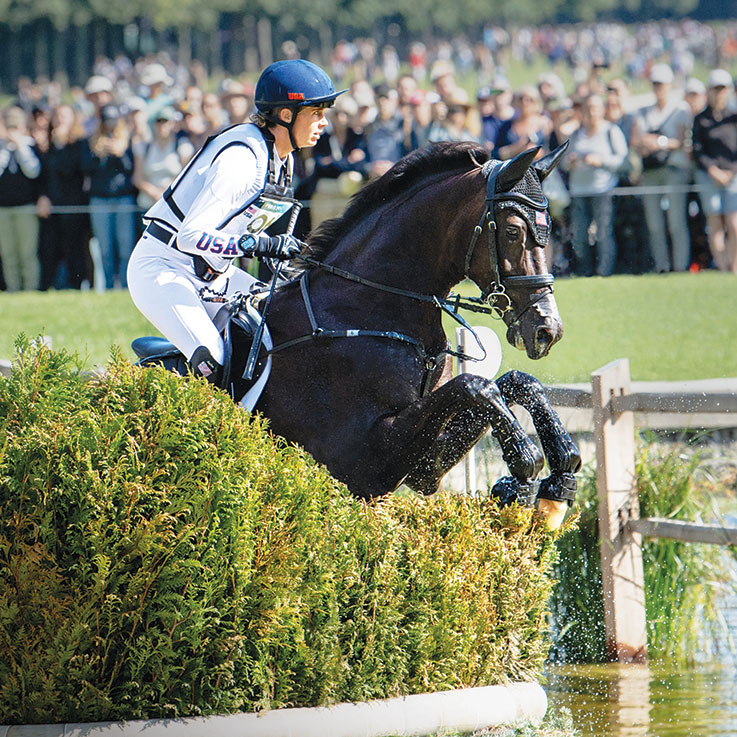
Caroline Pamukcu competed on HSH Blake in Paris.
PHOTO BY SHANNON BRINKMAN
Caroline Pamukcu: A Promising First Olympics
Making her Olympic debut, Caroline Pamukcu made a remarkable first appearance on the grandest stage of equestrian sports. The 29-year-old competed on HSH Blake (Tolan R x Doughiska Lass), a 9-year-old Irish Sport Horse, who is a product of her young horse training program. Blake was also her mount at the 2023 Pan American Games where they won individual gold and team silver. This young pair was the first to lead the way for Team USA and showcase their versatility and skill across the three phases of eventing: dressage, cross-country and show jumping. They earned a commendable score of 30.40 in dressage and set the stage for a solid position in the standings for Team USA. They were the sixth pair out over the cross-country course and the first for the U.S. Featuring 28 obstacles and a variety of technical challenges, Pamukcu navigated the demanding course with a blend of confidence and care. Her adept handling of Blake through the challenges was a testament to their preparation and partnership. They had an unfortunate slip in a ditch at the 16ABCD jump combination that led to 20 jump penalties, including time penalties that placed them with a score of 62.40. This was followed by a nicely delivered round in the show jumping course with four faults and a time penalty added, giving her a final score of 66.80.
Pamukcu’s performance was marked by a strong effort across all phases of eventing, although the duo did not secure a medal. She continues to be a rising star in the eventing community and a significant contender in international competitions. As Pamukcu and her young partnership with Blake continue to develop, she is sure to continue to make a lasting impact in the eventing world.
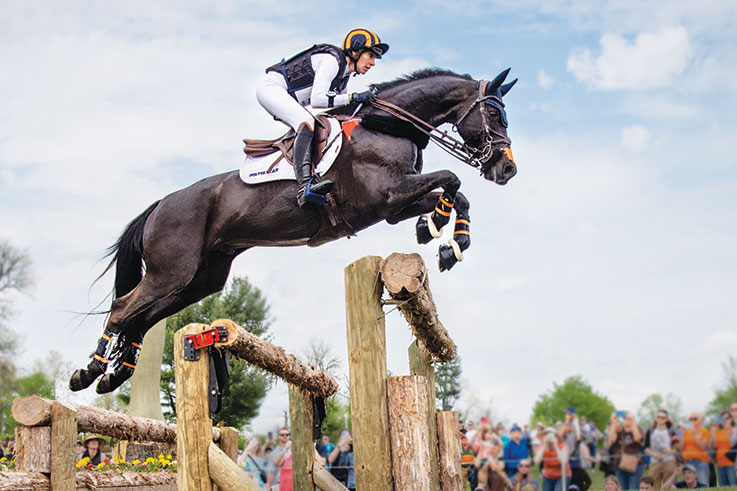
PHOTO BY SHANNON BRINKMAN
“Nutrition is crucial to the well-being of my horses, and that starts with supplements sourced with only the best ingredients. With a busy competition schedule, using Platinum allows each of the horses to stay healthy and well through it all.”
— Liz Halliday, Platinum Performance® Client since 2011
Liz Halliday: Earned Her Spot and More
Elisabeth “Liz” Halliday made a notable Olympic debut at the Paris Games, partnering with her horse Cooley Nutcracker (Tolan R. x Cobra), a 10-year-old Irish Sport Horse gelding. Back in 2021, Halliday was named to Team USA with Deniro Z (Zapatero VDL x Zonne-Trend) to compete at the Tokyo Games. Deniro Z, however, sustained an injury, and Halliday was unable to represent the U.S. At this year’s Paris Games, she was the traveling reserve but joined her eventing teammates on the competitive line after Will Coleman had to withdraw his mount Diablo. While it was bittersweet to see Halliday make her Olympic debut under such circumstances, it was also an elation to finally see her compete. It is a reminder that perseverance and love of the sport can lead to success even when the path to one’s goals is fraught with obstacles. Halliday and Nutcracker showcased their capabilities across dressage, cross-country and jumping. Their performance in dressage earned a strong score of 28 and was the highest score for Team USA. They navigated a demanding cross-country course with just six-time penalties, an impressive achievement. In the show jumping phase, the pair delivered a clear round. The 45-year-old qualified for the second round to determine individual medals and completed her first Olympics with an individual score of 40 penalties to place 19th individually. She and Nutcracker delivered a competitive performance of skill and strong partnership. Even though they did not medal individually or as a team, their performance significantly contributed to Team USA’s overall effort. There is no doubt that the experience has highlighted her as a standout competitor. We eagerly anticipate seeing her talent and determination on the international stage again. — After the Olympics, Liz Halliday sustained a significant injury during competition. We wish her a speedy and complete recovery. #keepfightingliz
2024 Equestrian Olympics: A Recap of Events Unfolding at the Palace of Versailles
Eventing
Great Britain Takes Home Team Gold
Eventing, the triathlon of equestrian sports, features a demanding combination of dressage, cross-country and show jumping. Great Britain won the team gold for the fifth time, with a score of 91.3 — the only team to score below 100 points. France put on a good performance coming into the jumping round with only a few more penalty points than Great Britain. With a score of 103.6 the team earned silver on home soil — a trifecta for France that also won gold in Rio and bronze in Tokyo. Japan made history with its first Olympic eventing medal, taking bronze with a score of 115.8.
Individual Competition Goes to Germany
The top-25 individual riders from the team competition were invited back for the individual round. Germany’s Michael Jung won gold on Fisherchipmunk FRH, becoming the first three-time individual champion. He delivered a masterful performance across all three phases. Australian Chris Burton claimed silver on Shadow Man. Great Britain’s Laura Collett also achieved individual success clinching individual bronze. She had a standout moment during the dressage phase, where she got a record-breaking score of 17.5. This score surpassed the previous Olympic record of 19.3 and demonstrated that her partnership with mount London 52 was one to watch right out of the gate.
Team USA’s Performance
The United States team faced a challenging start when Will Coleman, originally slated to compete with his horse Diablo, had to withdraw due to a hoof abscess. Despite losing the duo, Caroline Pamukcu on HSH Blake, Boyd Martin on Federman B and Liz Halliday on Cooley Nutcracker rallied and competed with determination. They finished seventh out of the 16 competing teams, with a final total score of 133.70. Qualifying in the top 25, teammates Martin and Halliday advanced to the individual jumping final where they finished 10th and 19th, respectively. Martin, representing the U.S. for the fourth time, achieved his first top-10 finish.
Show Jumping
USA Secures Third Olympic Team Silver
Show jumping captivated audiences with its high-stakes, fast-paced action. Great Britain delivered a nearly faultless performance with only two time penalties earning the team gold. The U.S. earned team silver — its third Olympic team silver medal following successes at the 2016 Rio Olympics and Tokyo in 2021. The team silver was achieved through strong performances with only four penalties. Laura Kraut and Baloutinue led the way and had a four-fault finish. Riding Caracole de la Roque, the team reserve Karl Cook delivered a clear and fast round. Kent Farrington had to pull Greya from the competition the day before the team qualifiers. Chef d’Equipe Robert Ridland said the reasoning was allergy-related. McLain Ward, the anchor rider on Ilex, also jumped clear with a good time, ensuring no additional penalties. France, feeling the pressure to medal on home soil, received the bronze with a total of seven penalties. With a combined time that was 0.57 seconds faster than the Dutch team, which also had seven penalties, it was a nail-biting finish for bronze.
Individual Competition Jump-Off
The 30 best horse-rider combinations from the individual qualification advanced to the individual medal competition. Only three had perfect rounds to secure a spot in the jump-off round. Germany’s Christian Kukuk and Checker 47 won the individual gold as the only rider with a double clear round. Steve Guerdat and Dynamix de Belheme from Switzerland earned the silver spot with a clear round followed by a rail down in the jump-off. Maikel van der Vleuten from the Netherlands on Beauville Z claimed bronze with a rail down but with a slower time. America’s Laura Kraut and Karl Cook earned spots in the individual finals coming in at eighth and 16th place, respectively.
Dressage
Germany Dominates
In dressage, the competition was fierce, showcasing the grace, precision and harmony required in this elegant discipline. Germany showcased its dominance, winning team and individual gold. Jessica von Bredow-Werndl won individual gold with a score over 90%, with a performance that was a masterclass in harmony and finesse. Teammate Isabell Werth on Wendy de Fontaine was not one to be outshined, earning silver with a score of 89.6% — making her the most-decorated equestrian ever with 14 Olympic medals. Moreover, she is the first athlete to win a medal at seven different Olympic Games. Helping them secure team gold was Frederic Wandres on Bluetooth OLD. Germany’s team score of 235.790 narrowly beat Denmark’s 235.669. Denmark had wonderful performances that earned them their first team silver medal. Great Britain took bronze with 232.492 points making this their fourth consecutive medal. Charlotte Fry from Great Britain earned individual bronze with 88.9%.
Setbacks for Team USA
Team USA faced some misfortunes this year. Marcus Orlob and Jane were disqualified due to a blood rule violation during their FEI Grand Prix performance. It is believed that Jane stepped on herself coming into the arena resulting in a small nick to the mare’s fetlock. The FEI blood rules for Dressage state that a horse seen with fresh blood will be eliminated from the competition. Unable to substitute their traveling reserve Endel Ots and Bohemian once the competition was underway, the U.S. could not compete for the team medal. Individually, team members Adrienne Lyle, a three-time Olympian competing on Helix, and Steffen Peters, a seven-time Olympian riding Suppenkasper, did not qualify for the individual FEI Grand Prix Freestyle. Although it was disheartening for Team USA to be absent from both the team and individual stages, the team showcased remarkable resilience and dedication despite setbacks.
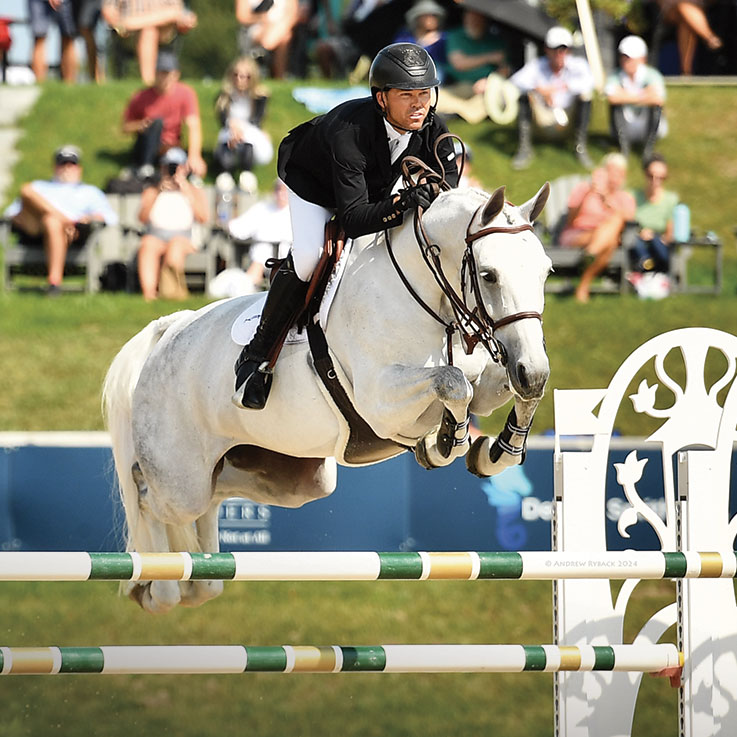
Team USA’s Kent Farrington had to withdraw from the competition due to an allergy-related issue with his mount Greya.
PHOTO BY ANDREW RYBACK PHOTOGRAPHY
Team USA’s Kent Farrington had to withdraw from the competition due to an allergy-related issue with his mount Greya.
PHOTO BY ANDREW RYBACK PHOTOGRAPHY
Kent Farrington: A Difficult Withdrawal and a Continued Legacy
Kent Farrington’s journey at the Paris Games was marked by an unfortunate turn of events. Despite entering as one of the top contenders in show jumping, Farrington had to withdraw from the competition, putting the needs of his horse Greya (Colestus x Contessa) first. Chef d’Equipe Robert Ridland said the reasoning was allergy-related. Greya, a 10-yearold Oldenburg mare has a long-standing presence on Farrington’s team. The pair recently came in fourth at the 2024 FEI Jumping World Cup Final in Riyadh, Saudi Arabia. The decision to withdraw her from Olympic competition surely came as a significant disappointment given Farrington’s established reputation and past successes on the international stage. The nature of equestrian sports often involves navigating unforeseen challenges, so there will always be highs and lows where the well-being of the horse will always take center stage.
Farrington’s career remains illustrious despite the recent setback. Over the years, the 43-year-old has consistently demonstrated exceptional skill and competitive spirit. He has achieved notable successes, including multiple victories at prestigious events and is already a three-time Olympian and a silver medalist from the 2016 quadrennial in Rio de Janeiro. His abilities have earned him a respected place among the elite show jumpers. Despite the 2024 Olympic setback, there is no doubt that Kent Farrington is a formidable presence in the sport. His dedication, experience and talent suggest that he will make a strong comeback for the upcoming Los Angeles Games, where his experience and skill are expected to shine once again.
Looking to the Future
As the equestrian community reflects on the inspiring performances that set new standards at the 2024 Olympics, we look forward with anticipation and aspirations. Commitment and passion to their sport — and their horses — brought these athletes to Paris. Pair this with experience gained and bonds shared and built, the groundwork for future success is set and will continue to fuel their pursuit of Olympic excellence. Teams and individuals will use those experiences to refine their strategies and skills as they face 2028. The promise of the Los Angeles Games will bring fresh challenges, renewed ambitions and the ever-present drive for excellence on the world stage. The global equestrian community is eager to again embrace the Olympic spirit and shine on — especially Team USA as the community eagerly anticipates seeing them soar on home soil.
Paris Games From the Veterinary Perspective
The 2024 Paris Olympics showcased the pinnacle of equestrian sport, and behind the scenes, a dedicated veterinary team ensured the health and well-being of the equine athletes. The Fédération Equestre Internationale (FEI) veterinary team played a crucial role in the smooth execution of the Games, combining expertise and meticulous planning to maintain the highest standards of equine care.

PHOTO BY DR. CHRISTOPHER ELLIOT
“We look for fitness to compete,” Dr. Emily Sandler-Burtness explained, emphasizing that the horse must be in a condition conducive to completing the competition successfully.
Dr. Emily Sandler-Burtness: Ensuring Excellence at the Paris Olympics
Dr. Emily Sandler-Burtness, a distinguished veterinarian and founder of Pacific Coast Equine Veterinary Services Inc. shares her behind-the-scenes perspective and ongoing commitment to equestrian welfare on an international stage. Based in Southern California, her practice focus is sports medicine and lameness, so she is well-versed in the practicalities of performance horses. Dr. Sandler-Burtness has worked over 15 years as an FEI veterinarian and is very much the horse enthusiast herself. She relished eventing growing up in Colorado and now enjoys the occasional tranquil trail ride with her husband and their two Quarter Horses.
At the Paris Olympics, she served as the 2024 FEI foreign veterinary delegate. It was her third Olympic Games, after service as a treating vet at the Rio de Janeiro Games and a commission member at the COVID-delayed Tokyo Games in 2021. In Paris, she was one of four FEI veterinary commission members, joined by colleagues from Brazil, the Netherlands and France.
The FEI foreign veterinary delegate plays a pivotal role in the Olympic equestrian events. This position involves overseeing the health and safety of horses and further ensuring they meet stringent fitness standards for competition. Dr. Sandler-Burtness described her role as a regulatory one: completing the veterinary report; stamping passports; and conducting horse inspections (jogs for the three disciplines). The jog, a critical part of the vetting process, assesses whether a horse is fit to compete, evaluating overall health and fitness beyond just lameness. “We look for fitness to compete,” she explained, emphasizing that the horse must be in a condition conducive to completing the competition successfully. Horse welfare is always a priority and ensuring these athletes’ well-being is central to her role.
The Paris Games was filled with rich culture and iconic landmarks. The equestrian events were held at the stunning grounds of the Palace of Versailles, where the horses received exceptional care with state-of-the-art facilities and services. The barns were climate-controlled, offering a stark contrast to the non-climate- controlled athletes’ village. The venue featured extensive grazing areas and two gallop tracks — one on grass and the other with footing — providing ample space for the horses to move and graze. All horses traveled with their own groom, and many teams brought their own farrier and veterinarian.
Preparation for the Olympics involved meticulous planning, including scenarios for various emergency situations. In Paris, unique challenges such as the cross-country course’s proximity to the Grand Canal (over a mile in length) required innovative safety measures, including boats with scuba-equipped emergency personnel. Dr. Sandler-Burtness praised France for its advanced animal rescue capabilities, noting that all fire departments have trained animal rescue staff. With the course covering such a large area, they also ensured a veterinarian was assigned to each of the 28 obstacles.
Despite some challenges with heat and humidity, the weather was more favorable than expected and no extreme conditions experienced with only a few days with temperatures in the 90s, unlike those seen in past Olympics such as Tokyo. The veterinary team used advanced tools like wet bulb globe thermometers and thermography cameras to monitor the ambient and horses’ temperatures, ensuring effective heat management.
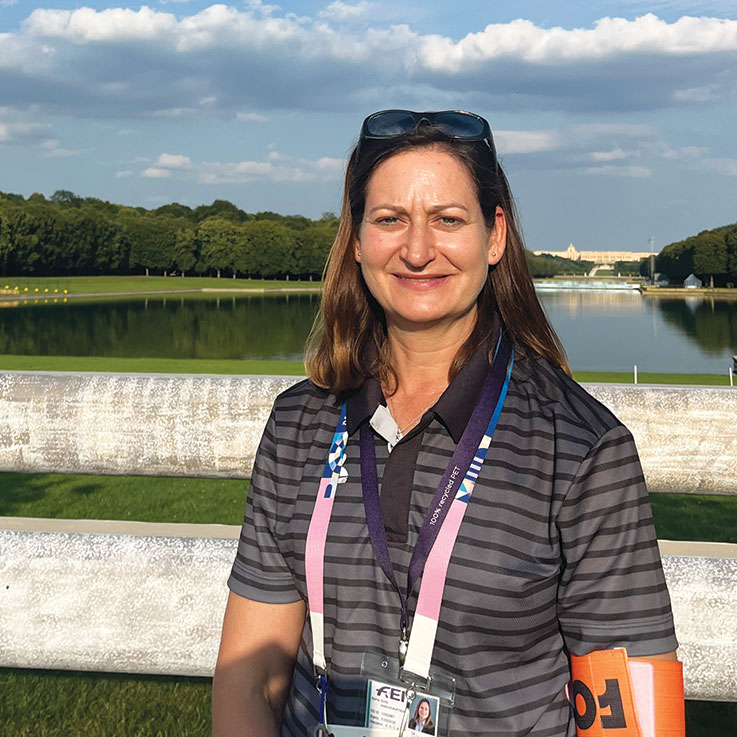
COURTESY PHOTO
The equestrian events at the Paris Olympics were held at the stunning grounds of the Palace of Versailles.
A Champion of Equestrian Welfare at the Olympics
Reflecting on the equestrian performances, Dr. Sandler-Burtness offered: “Paris 2024 showcased equestrian sport to the world in an amazing light. The venue was breathtaking, and the sport was fantastic, exciting and safe.” While watching horses and riders compete in Paris, she noted a few particularly memorable moments. Highlights include: Karl Cook’s and Caracole de la Roque’s clean round that helped earn Team USA’s silver medal victory, and the piaffe and passage performance of Maxima Bella — the youngest horse in the competition at 8 years old, two years younger than any other dressage mount — with Polish rider Sandra Sysojeva.
Dr. Sandler-Burtness commended the overall success of the Games, with no severe injuries reported and minor incidents managed effectively by a team of over 80 veterinary professionals. The on-site recovery facilities were well-equipped, and nearby world-renowned veterinary referral centers were available for more complex cases.
Looking ahead to future Olympics, Dr. Sandler-Burtness expressed hope for continued improvements, particularly in maintaining high standards of horse welfare. She praised the new addition of the role of equine welfare coordinator to this year’s Olympics, who monitored and offered advisory oversight on the horses’ welfare throughout the competition. She emphasized the collective responsibility of the equestrian community to enhance the sport's perception and ensure its positive portrayal.
As the world anticipates the 2028 Olympics in Los Angeles, Dr. Sandler-Burtness looks forward to showcasing equestrian sport on home soil, building on the successes of Paris.
